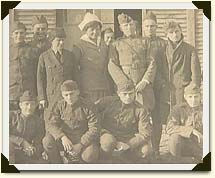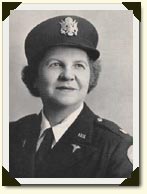Courtesy of Great-Aunt Mary:
On July, 18, 1876, Peter Gavin married Anastacia Ryan in a small ceremony in Charlottetown, Prince Edward Island. Peter was well respected in the community and in a few short years was elected to the Canadian Parliament. By then, Anna had given birth to two girls, Nellie and Jean, and was pregnant with their first son, Frank. Mary Gavin was born in the middle of winter in 1883, and was soon followed by Louis
Nellie died at the age of nine. Grief-stricken, Peter moved the family St. Paul, Minnesota. He became a superintendent for the Santa Fe Railroad. It was in St. Paul that Peter and Anna’s last child, George, was born. They watched helplessly when, just before his second birthday, the child became ill with croup and died.
In 1900, Mary’s older brother Frank moved to Spokane, Washington, to work for the Great Northern Railroad. The family followed him out. Peter and Louis also found work with the Railroad. Frank would eventually become the third President of the Great Northern Railroad.
Nursing School
For most women at the turn of the century, if a woman had to (or wanted to) support herself, her choice of jobs was limited to teaching, nursing or domestic work. Great, great aunt Mary chose teaching.
She stayed just two years in the public schools of Spokane. In 1905, Mary packed her bags and traveled across the country to Baltimore to attend the University of Maryland School of Nursing. In those days, nurses were paid to attend school and were expected to work in the University Hospital from the day they arrived. Three years later, Mary received her nursing certificate and became the 734th nurse to register in Maryland.
The Great War
On April 12, 1917, the United States declared war on Germany. The Army called upon University Hospitals across the country to organize base hospitals. As they were organized, they were numbered, and Mary’s unit, Base Hospital 42 was ready the spring of 1918.
One hundred nurses and two civilians sailed from New York City on July 14, 1918 aboard the Baltic of the White Star Line. Two weeks later they arrived in Bazoilles-Sur-Meuse, 40 miles south of the Western Front. Bazoilles was the center for seven American Hospitals.
“We had been at the hospital just a week when we received our first patients. They were not very ill ones, mostly walking cases. A few days later we received our first convoy of really ill patients when 150 very badly gassed cases were admitted to the hospital. It was then that we got our first taste of the horrors of war. These men were suffering acutely, their bodies were badly burned and their eyes in awful condition, besides the inevitable chest complication that accompanies such cases. We are proud to be able to say that we did not lose one of these patients.”
In September, the nursing personnel of B. H. 42, lost two of its own Frances Moeschen, who had been on loan to the Army Red Cross Hospital #5, in Paris, and Charlotte Cox, Mary’s assistant. Charlotte had fallen ill with dysentery the day before she was to have been sent to assist at an Evacuation Hospital at the front. She never recovered, and on September 30th was buried in the
hospital cemetery with honors.
It was during that time that the real rush began. The battles at Verdun and St. Mihiel brought more and more wounded to the hospitals. Forty of the hundred nurses that Mary had brought with her had been loaned out to other hospitals, and many of those remaining were sick with pneumonia or influenza.
“It was impossible to arrange and live up to a schedule. During these strenuous weeks it was not at all unusual for a nurse to remain on duty 18 hours, not just for one day, but for many days in succession.”
Ten of the nurses who had been loaned to Base Hospital 18 were sent back in the beginning of October. During that month, Base Hospital 42 acted as an evacuation hospital and moved the operative cases on as soon as possible in order to make room for the next wave. Even so, there were always 1200 to 1800 patients in the hospital.
On November 11, 1918, at 11 a. m., the guns stopped. Armistice was signed. People around the world celebrated and in Paris crowds hung signs crying “Vive Wilson!” “In the little town of Bazoilles there was much rejoicing, lights were lighted for the first time since we had been there, the church bells rang continuously, and the streets were filled with a throng of women and children, their faces beaming with happiness. It was easy to realize their feeling of deliverance from a mighty terror.”
With the war over, the nurses were given the option to sign on for further service in the A. E. F. Forty one did so and were re-assigned to Evacuation Hospital 21. The rest left for the States on January 28, 1919.
“Thus Base Hospital 42 ceased to exist, officially, but the nursing personnel had been a very happy family and the organization will never cease to exist in their minds and hearts. They came home with the consciousness of work well done, of splendid results achieved in spite of the handicaps met, and of hardships borne uncomplainingly, and I feel sure that every one of them feels well repaid for any sacrifice she may have made when she responded so promptly to the country’s call for nurses.”
The Army
When Mary returned to the United States, she was assigned to the Office of the Surgeon General in Washington, D. C. In 1920, Army nurses were given “relative rank” (rank in name only) and Mary was made a First Lieutenant. Four years later, while serving as the Chief Nurse at the General Dispensary in New York City, Mary received the French Medaille d’Epidemies for her service in Bazoilles.
Mary was promoted to the rank of Captain on November 1st, 1940. For the next four years, until she retired, Mary recruited nurses for World War II. On March 23, 1943, Mary was promoted to the rank of Lieutenant Colonel.
When Mary retired, a testimonial dinner was thrown for her at the Piedmont Driving Club in Atlanta, GA. The following is an excerpt from a newspaper article about the event:
“There was no master of ceremonies. No head table. Captain MacDonald just stood up and said she was honestly proud to be there, and presented Colonel Florence Blenchfield, head of all the Army nurses, who traveled from Washington to join the celebration.
“A little nurse once paid the finest tribute in the world to Colonel Gavin, ” said Colonel Blenchfield. “She said, I don’t know how to describe her to you, but I only know that I wish I could grow up to be just like her.'”
Mary moved to New York City. She lived there until her death on November 13, 1968, 50 years and 2 days after the Armistice was signed. She was buried in Arlington Cemetery with military honors.
-
Maryl Gavin, first woman on the left, at Hospital Number 42
-
Mary Gavin At Age 60
Michael Robert Patterson was born in Arlington and is the son of a former officer of the US Army. So it was no wonder that sooner or later his interests drew him to American history and especially to American military history. Many of his articles can be found on renowned portals like the New York Times, Washingtonpost or Wikipedia.
Reviewed by: Michael Howard


